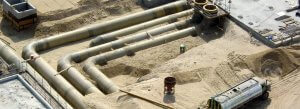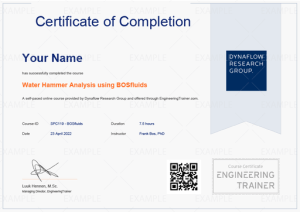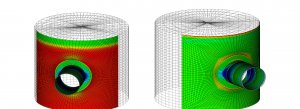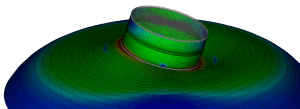
PV-Elite
Training Courses PV-Elite About The Course Whether you are designing a pressure vessel according to the ASME VIII, PD5500 or EN 13445, PV-Elite offers you
Enhance your proficiency with FEPipe software through a comprehensive training program. Suitable for both new and experienced users, this course covers a wide spectrum of FEPipe aspects, including analysis of standard geometries, custom attachments, plate-based constructions, and assemblies of multiple models. It provides an in-depth exploration of the entire workflow, covering model verification, boundary conditions, and result visualization options. Additionally, advanced modeling features, flange analysis, thermal transient analysis, mechanical eigenmodes calculation, and more are discussed, along with software modules like AxiPRO and Stressplot from the PRG Suite, which are closely related to FEPipe.
The training also includes in-depth seminars on Part 5 of ASME BPVC VIII-2, ensuring participants are well-versed in ‘Design by Analysis’ assessments.
This course comprises 7 modules. Upon course completion, you’ll enjoy one year of unlimited access to the course content and discussion forum, allowing you to revisit modules as needed to reinforce your knowledge for project applications
Introduction to Finite Element Analysis
Introduction to FEPipe
Template Roadmap – Which template should I use?
Exercise: Stress categorization
The Nozzle, Plate & Shell Template
Plotting and Model Verification Tools
Exercise: A basic FEPipe model
Exercise: Modelling a vessel with various nozzles
Exercise: Vessel-Nozzle Geometry with nozzle end loads
Piping considerations
Modeling in the String Template
Exercise: Modelling piping actions
Exercise: B31.3 SIF comparison
Exercise: Modeling Piping Actions
Database Operations
Exercise: Database Operations
Structural Attachments
Exercise: Structural Attachments
How to apply line and surface loads in FEPipe
The Axisymmetric Template
Flange assessment using AxiPRO
Modeling Tube Bundles with AxiSymmetric Template
Introduction to Fatigue Analysis
Stress Linearization with StressPlot
Exercise: Axisymmetric Template & Stress Linearization
Exercise: Fatigue assessment
Exercise: Thermal Transient
Exercise: Stress Linearization
Introduction to Dynamic, Modal & Buckling Analysis
Exercise: Buckling due to external pressure
Exercise: Elastic Column Buckling, Natural Frequencies and Harmonic Excitation
3D drawing tools
Plastic/non-linear assessment
Self-Paced
This course is self-paced and is not subject to specific dates. The course contains 7 modules with a total of 12 hours of content which can be performed at your own pace. A Personal Certificate will be provided to you if you finish the course within the first month after purchase. This incentive will motivate you to perform the course quickly thereby improving your learning curve.
E-Hybrid
This course is scheduled regularly with a drip feed of modules becoming available to the participants throughout the program. The drip schedule aims to provide consistency to your learning experience and is designed to maintain participant concentration and provide adequate time to perform exercises between live instructor sessions where the instructor may answer any questions about the topic.
This course type is also available for a private schedule for teams of a minimum of 4 people.
Spring Program:
Fall Program:
Classroom
This course is scheduled over 2 work days. The dates of the course are organized upon inquiry.
This course is available in self-paced, hybrid, and classroom formats.
Prerequisites and level
Intended For
This course is designed for:
Access to the self-paced course
After your purchase is confirmed you receive an account to the EngineeringTrainer online learning portal, where you can find the course in your dashboard. After opening the course you will be guided step-by-step through the different modules. You receive 1-year unlimited access to the course, allowing for the repetition of modules as desired.
Learn by doing
The self-paced and E-hybrid courses are mainly based on video content: video lectures and video software demonstrations. English subtitles are available and videos can be viewed as many times as desired. The video lectures help you to grasp the important technical concepts and in the video demonstrations the instructor uses the software and discusses all the steps and actions. You are recommended to follow the steps of the instructor in the software to optimize your learning curve.
The classroom course is performed in person either on-site or in the Dynaflow Research Group office located in Rijswijk, The Netherlands. This course enables you to be face-to-face with the instructors with live examples provided. This course also provides all participants with a 1-year access to the self-paced course.
Exercises and software models associated with the content are available for download.
Participants of the self-paced and E-hybrid courses receive a personal digital certificate if they meet the following requirements:
Participants of the classroom course receive a personal physical certificate upon the completion of the course.
Example certificate:

After this course, participants are expected to:
Video lectures,
Calculation exercises,
Instructor-led live sessions with lectures, group discussions, exercises and Q&A’s,
Discussion forum with other participants & instructor.
Videos will not be available for download, but can be accessed directly with your account on the portal. If slides are used in the videos or live sessions these can be viewed separately as well through the portal, but are not available for download.
You receive 1-year unlimited access to the course. This allows you to watch content again if this is beneficial for your work projects.
Yes, live sessions are included in this course that allow you to interact with the instructor and ask questions. Additionally, questions can be submitted in the learning portal by the participants which are addressed in the live sessions.
An active FEPipe license is required for this course. In the course it is assumed that the participants have access to the software. This software license is not included in the course. Please contact us for questions on this matter.
Self-paced Modules
If your computer and internet connection are able to play videos online and have MS Teams calls you will be able to follow the course. Note that almost all browsers are supported, except for Internet Explorer.
Live sessions
Live events are provided by means of Microsoft Teams. Hence it required to have an MS Teams account. Additionally, a webcam and microphone are mandatory for the live events. Separate earplugs are recommended as to avoid sound echo.
Yes, this course qualifies for PDH hours as per the NCEES CPC Guidelines.

Training Courses PV-Elite About The Course Whether you are designing a pressure vessel according to the ASME VIII, PD5500 or EN 13445, PV-Elite offers you

Training Courses NozzlePRO Essentials Free Course Preview Download Brochure About The Course This self-paced course teaches you all the fundamentals, and much more, about working

Training Courses FEPipe Essentials Download Brochure About The Course Enhance your proficiency with FEPipe software through a comprehensive training program. Suitable for both new and
Laan van Oversteen 20
6th floor
2289 CX Rijswijk
The Netherlands
© Dynaflow Research Group BV